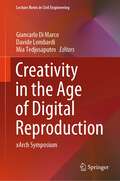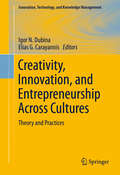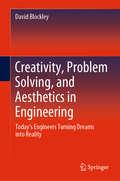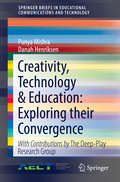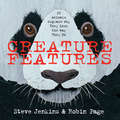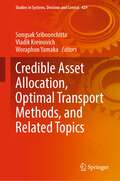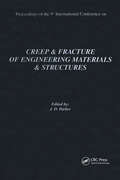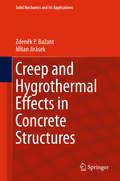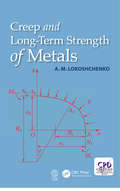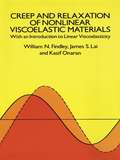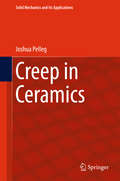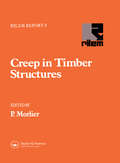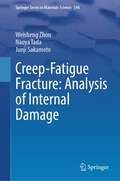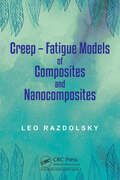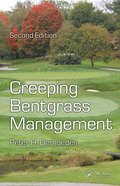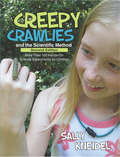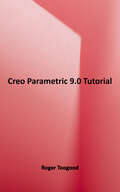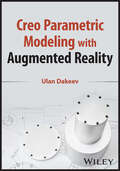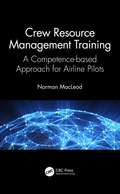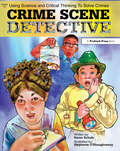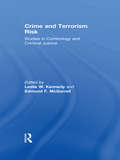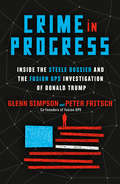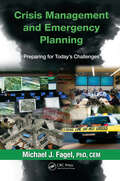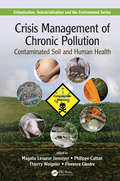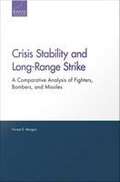- Table View
- List View
Creativity in the Age of Digital Reproduction: xArch Symposium (Lecture Notes in Civil Engineering #343)
by Davide Lombardi Giancarlo Di Marco Mia TedjosaputroInspired by this symposium we would like to rethink and provide an insight about the use of new technologies in architecture and design. The consideration spans over (but not limited to) computational design, virtual experience, digital fabrication, artificial intelligence and sustainability/environment. Readers of the proceedings will benefit from discussions on how adoption of new technologies can benefit the Construction Industry rather than just for the sake of leveraging new technologies. The book targets scholars and high-education level students, as well as Ph.D.s which research falls into the broad realm of digital design.
Creativity, Innovation, and Entrepreneurship Across Cultures: Theory and Practices (Innovation, Technology, and Knowledge Management)
by Elias G. Carayannis Igor N. DubinaThe aim of this volume is to further develop the relationship between culture and manifold phenomena of creativity, innovation and entrepreneurship in order to promote further and better understanding how, why, and when these phenomena are manifested themselves across different cultures. Currently, cross-cultural research is one of the most dynamically and rapidly growing areas. At the same time, creativity, inventiveness, innovation, and entrepreneurship are championed in the literature as the critical element that is vital not just for companies, but also for the development of societies. A sizable body of research demonstrates that cultural differences may foster or inhibit creative, inventive, innovative and entrepreneurial activities; and each culture has its own strengths and weaknesses in these regards. Better understanding of cultural diversity in these phenomena can help to build on strengths and overcome weaknesses. Cross-cultural studies in this field represent a comparatively new class of interdisciplinary research. This is a field where cultural, sociological, psychological, historical, economic, management, technology and business studies closely intersect. In this book, a global team of researchers representing Europe, Asia, and the Americas review, analyze, structure, systematize and discuss various concepts, assumptions, speculations, theories, and empirical research which focus on the effect of national cultures on creativity, invention, innovation, and entrepreneurship. They argue that national culture is not only an extremely important determinant of innovation and business development, but also demonstrate that some aspects relating to these phenomena may be universal among all cultures, thereby identifying those factors that may easily be transferred across cultures from those that are unique to their specific context.
Creativity, Problem Solving, and Aesthetics in Engineering: Today's Engineers Turning Dreams into Reality
by David BlockleyThis book illuminates what engineering is and how it relates to other disciplines such as art, architecture, law, economics, science, technology, and even religion. The author explains, from an intrinsic as well as descriptive perspective, why engineering is essential for our collective well-being, and how, like medicine, it is undertaken by people, and for people, to improve the human condition. He brings out the 'magic' of engineering practice as well as addressing the darker aspects such as warfare and the misuse of the internet. A too commonly held view assumes that the practice of engineers is a cold, purely quantitative and wholly technical enterprise of applying know science, and devoid of creativity or aestheticism. In 2013 the United States National Academy of Engineering launched a campaign called “Changing the Conversation, Messages for Improving Public Understanding of Engineering” with four messages to impart about engineers: that they make a world of difference; are creative problem solvers; that they help shape the future, and are essential to health, happiness, and safety. In this volume, Professor Blockley incorporate these messages into an engaging exposition of engineering accomplishment in all of its evolving diversity, from the technician to the academic research engineer, illustrating the continuum of thinking and purpose from the fixer of the gas boiler to the designers of the A380 and the iPhone.
Creativity, Technology & Education: Exploring their Convergence (SpringerBriefs in Educational Communications and Technology)
by Danah Henriksen Punya MishraIn this collection of beautifully written essays, Mishra, Henriksen, and the Deep-play Research Group challenge myths about technology and creativity, debate time-honored instructional practices, and play with new ideas for schools to care for and nurture, rather than constrain, creativity. These essays are provocative . . . refreshing, [and] insightful --Dr. Yong Zhao, Foundation Distinguished Professor, University of Kansas and Fellow, Mitchell Institute for Health and Education Policy, Victoria University, Australia. What is creativity? Why is it important? What does it look like across different disciplines and contexts? What role does technology play, if any, in the creative process? And finally, what do creativity and technology have to do with education? These are the questions that underlie the collection of articles in this book. These essays provide a broad analytic frame for thinking about creativity, technology and education and describe classroom examples as well as strategies for evaluating creative artifacts and creative environments. All of these are grounded in specific examples from across a wide range of disciplines and contexts--art, mathematics, engineering, computer science, graphic design, architecture, science to name just a few. The final essays take a broader perspective on creativity and technology focusing both on our highly inter-connected YouTube world but also possibilities for the future. Creativity, Technology & Education: Exploring their Convergence is a vital resource for educators and practitioners as they seek to incorporate creative work and thoughtful pedagogy in their personal and professional lives.
Creature Features: Twenty-Five Animals Explain Why They Look the Way They Do
by Steve Jenkins Robin PageDear axolotl: Why do you have feathers growing out of your head? Axolotl: They aren't feathers—they're gills! They let me breathe underwater. Let's face it. Even as babies, we humans pay close attention to faces. Observing another person's features and expressions tells us whether they are happy, angry, excited, or sad. And when we look at an animal, it's hard not to imagine that its face is communicating human feelings. This isn't true, of course. Squinty eyes, an upturned mouth, or another odd expression is probably there because, in some way, it helps that animal survive. Packed with many cool facts and visuals on where certain animals live and what they eat, this book captures twenty-five humorous—and very true—explanations of why animals look the way they do in order to exist in this world.
Credible Asset Allocation, Optimal Transport Methods, and Related Topics (Studies in Systems, Decision and Control #429)
by Vladik Kreinovich Songsak Sriboonchitta Woraphon YamakaThis book describes state-of-the-art economic ideas and how these ideas can be (and are) used to make economic decision (in particular, to optimally allocate assets) and to gauge the results of different economic decisions (in particular, by using optimal transport methods). Special emphasis is paid to machine learning techniques (including deep learning) and to different aspects of quantum econometrics—when quantum physics and quantum computing models are techniques are applied to study economic phenomena. Applications range from more traditional economic areas to more non-traditional topics such as economic aspects of tourism, cryptocurrencies, telecommunication infrastructure, and pandemic. This book helps student to learn new techniques, practitioners to become better knowledgeable of the state-of-the-art econometric techniques, and researchers to further develop these important research directions
Creep and Fracture of Engineering Materials and Structures: Proceedings of the 9th International Conference
by J D ParkerThis volume contains the 75 papers from the Proceedings of the 9th International Conference on Creep and Fracture of Engineering Materials and Structures, held at University of Wales Swansea, 1st April- 4th April 2001.
Creep and Hygrothermal Effects in Concrete Structures (Solid Mechanics and Its Applications #225)
by Zdeněk P. Bažant Milan JirásekThis comprehensive treatise covers in detail practical methods of analysis as well as advanced mathematical models for structures highly sensitive to creep and shrinkage. Effective computational algorithms for century-long creep effects in structures, moisture diffusion and high temperature effects are presented. The main design codes and recommendations (including RILEM B3 and B4) are critically compared. Statistical uncertainty of century-long predictions is analyzed and its reduction by extrapolation is discussed, with emphasis on updating based on short-time tests and on long-term measurements on existing structures. Testing methods and the statistics of large randomly collected databases are critically appraised and improvements of predictions of multi-decade relaxation of prestressing steel, cyclic creep in bridges, cracking damage, etc. , are demonstrated. Important research directions, such as nanomechanical and probabilistic modeling, are identified, and the need for s eparating the long-lasting autogenous shrinkage of modern concretes from the creep and drying shrinkage data and introducing it into practical prediction models is emphasized. All the results are derived mathematically and justified as much as possible by extensive test data. The theoretical background in linear viscoelasticity with aging is covered in detail. The didactic style makes the book suitable as a textbook. Everything is properly explained, step by step, with a wealth of application examples as well as simple illustrations of the basic phenomena which could alternate as homeworks or exams. The book is of interest to practicing engineers, researchers, educators and graduate students.
Creep and Long-Term Strength of Metals
by A. M. LokoshchenkoCreep and Creep Rupture of Metals is devoted to the fundamental description of the phenomenon of creep which occurs widely in high-temperature deformation of metals. Special attention is paid to the analysis of long-term strength, which characterizes the stress at which the metal does not fail after a predetermined time. The author details experimental and theoretical results obtained by Soviet and Russian scientists that are absent in currently available publications and demonstrates analytical methods and approaches to achieve long term strength in Metals.
Creep and Relaxation of Nonlinear Viscoelastic Materials (Dover Civil and Mechanical Engineering)
by Francis A. Davis William N. FindleyThis pioneering book presents the basic theory, experimental methods, experimental results and solution of boundary value problems in a readable, useful way to designers as well as research workers and students. The mathematical background required has been kept to a minimum and supplemented by explanations where it has been necessary to introduce specialized mathematics. Also, appendices have been included to provide sufficient background in Laplace transforms and in step functions. Chapters 1 and 2 contain an introduction and historic review of creep. As an aid to the reader a background on stress, strain, and stress analysis is provided in Chapters 3 and 4, an introduction to linear viscoelasticity is found in Chapter 5 and linear viscoelastic stress analysis in Chapter 6. In the next six chapters the multiple integral representation of nonlinear creep and relaxation, and simplifications to single integral forms and incompressibility, are examined at length. After a consideration of other representations, general relations are derived, then expanded to components of stress or strain for special cases. Both constant stress (or strain) and variable states are described, together with methods of determining material constants. Conversion from creep to relaxation, effects of temperature and stress analysis problems in nonlinear materials are also treated here. Finally, Chapter 13 discusses experimental methods for creep and stress relaxation under combined stress. This chapter considers especially those experimental problems which must be solved properly when reliable experimental results of high precision are required. Six appendices present the necessary mathematical background, conversion tables, and more rigorous derivations than employed in the text. An extensive updated bibliography completes the book.
Creep in Ceramics (Solid Mechanics and Its Applications #241)
by Joshua PellegThis textbook is one of its kind, since there are no other books on Creep in Ceramics. The book consist of two parts. In part A general knowledge of creep in ceramics is considered, while part B specifies creep in technologically important ceramics, namely creep in oxide ceramics, carnides and nitrides. While covering all relevant information regarding raw materials and characterization of creep in ceramics, the book also summarizes most recent innovations and developments in this field as a result of extensive literature search.
Creep in Timber Structures
by P. MorlierThis book brings together up to date information from research and practice about the interaction between moisture changes and mechanical loading, which may lead to excessive deflections or joint movements in timber structures. It has important applications in timber engineering, and consequences for national and international structural codes of practice.
Creep-Fatigue Fracture: Analysis of Internal Damage (Springer Series in Materials Science #344)
by Junji Sakamoto Weisheng Zhou Naoya TadaThis book presents a detailed analysis of the processes of internal damage and healing of damage in high-temperature creep-fatigue. This analysis is based on experimental results and a three-dimensional visualization and simulation method. It focuses on inner cracking type fracture, which is essential to consider for creep-fatigue in actual equipment and structures used at high temperatures for long periods of time. In this book, systematic studies of the fracture are presented by introducing three-dimensional simulation and visualization methods. This book is for designers and researchers in industry specializing in strength of materials at high temperatures. It is also for a postgraduate or higher academic audience specializing in mechanical engineering and materials science engineering. In reading the book it is expected that readers will acquire knowledge of evaluation techniques for high-temperature creep-fatigue damage. In addition, this book allows readers toimprove the accuracy of damage evaluation, design materials for longer lifetimes, and apply the described techniques to other materials.
Creep: Fatigue Models of Composites and Nanocomposites
by Leo RazdolskyIn recent years, the application of composites and nanocomposites has been increasing steadily in industries such as aerospace, automotive, marine, and civil engineering. It is among the most complex and crucial aspects of the mechanics of a deformable solid, due to several specific phenomena and analytic factors arising from cyclic loading. The problems are primarily associated with the development of fatigue damage, and the need to assess the cyclic and structural instability of composite and nanocomposite materials. The study of structural strength under cyclic loading has gained much attention, especially in aircraft manufacturing, power engineering, aviation, and rocket technology. Cyclic loading significantly reduces creep-fatigue lifespan during the entire frequency range. It is clear that characteristics such as endurance limit, static creep limits and long-term static strength will not suffice in the design criteria for fatigue life. New aspects have emerged in high-temperature strength - cyclical creep and long-term cyclic strength, leading to the creation of new methods and means of determining the resistance of composites and nanocomposites materials and continuum damage development under cyclic loading to the creation of appropriate physical models. Particularly relevant is the intensification of creep by high-frequency cyclic loading in composite materials, which usually occurs at high temperatures. Most studies in the field of cyclic creep are experimental, and the direct use of number of cycles to define damage model cannot escape the empirical relation that predicts multi-stress level fatigue life well. The book presents new phenomenological cyclic creep – fatigue models for describing the fatigue life and behavior of time-dependent composites and nanocomposites. Since the main difference between the creep process from the fatigue process is that from a physical point of view, the first is quasi-static, and the second is dynamic. Therefore, the functions of creep should reflect the oscillatory nature of the fatigue process. The results are supported by step-by-step practical design examples and will be useful for practicing structural engineers, code developers as well as research and university faculty.
Creeping Bentgrass Management
by Peter H. DernoedenCreeping bentgrass is considered the premier turfgrass species grown on golf courses, and there is a growing demand for an understanding of its maintenance and management practices. Still the only comprehensive reference on the subject, Creeping Bentgrass Management, Second Edition helps you identify the factors that contribute to summer bentgrass
Creepy Crawlies and the Scientific Method
by Sally KneidelFrom monarch butterflies to hissing cockroaches, Creepy Crawlies and the Scientific Method, Second Edition shows teachers and parents how to use bugs, insects and critters to teach children the five steps of the scientific method: question, hypothesis, methods, result, and conclusion. Focusing on fun as well as education, and operating on the premise that doing is learning, Creepy Crawlies offers more than 100 different activities which will ignite children's curiosity while also building foundations for critical thinking and scientific understanding. This classroom-tested collection of experiments is a perfect resource for teachers or just an afternoon of educational fun at home. The second edition includes updated content and four new insect species: the monarch butterfly, the black swallowtail butterfly, the bessbug, and the Madagascar hissing roach!Sally Kneidel, PhD, grew up next to a small creek and experienced crawling creatures at an early age. Her interest led her to ultimately pursue a PhD in biology from the University of North Carolina-Chapel Hill. Kneidel has now taught for more than fifteen years, including college biology courses and writing classes. She writes on a variety of science topics, ranging from health to wildlife conservation, has published numerous other books, and has won several awards for writing, blogging, and photography. The first edition of this book, and the sequel to it, were both named in Science Books & Films' "Best Books for Children" list.
Creo Parametric 9.0 Tutorial
by Roger ToogoodThe eleven lessons in this tutorial introduce you to the design capabilities of Creo Parametric 9.0. The tutorial covers the major concepts and frequently used commands to advance from a novice to an intermediate user level. Major topics include part and assembly creation and the creation of engineering drawings. Also illustrated are the major functions that make Creo Parametric a parametric solid modeler. Although the commands are presented in a click-by-click manner, an effort has been made, in addition to showing/illustrating the command usage, to explain why certain commands are being used and the relation of feature selection and construction to the overall part design philosophy. Simply knowing where commands can be found is only half the battle. As is pointed out numerous times in the text, creating useful and effective models of parts and assemblies requires advance planning and forethought. Moreover, since error recovery is an important skill, considerable time is spent exploring the created models. In fact, some errors are intentionally induced so that users will become comfortable with the "debugging" phase of model creation. At the end of each lesson is a short quiz reviewing the new topics covered in that chapter. Following the quiz are several simple "exercise" parts that can be created using new commands taught in that lesson. In addition to these, an ongoing project is also included throughout the book. This project consists of several parts that are introduced with the early lessons and finally assembled at the end. Who this book is for This book has been written specifically with students in mind. Typically, students enter their first CAD course with a broad range of abilities, both in spatial visualization and computer skills. The approach taken here is meant to allow accessibility to persons of all levels. These lessons, therefore, were written for new users with no previous experience with CAD, although some familiarity with computers is assumed.
Creo Parametric Modeling with Augmented Reality
by Ulan DakeevCreo Parametric Modeling with Augmented Reality Tutorial-based introduction to 3D Modeling with Creo Parametric, including images to be scanned and viewed using an AR mobile app Using a tutorial approach, Creo Parametric Modeling with Augmented Reality provides an introduction to the modeling techniques and functionality of Creo Parametric, beginning with an overview of parametric design and Creo’s sketching capabilities and 3D tools; proceeding through design methods and skills related to patterns, dimensions, sections, assemblies, and tolerances and GD&T; and concluding by connecting Creo’s capabilities to the more specialized skills of Finite Element Analysis, mechanism animation, and sheet metal design. Each chapter includes highly visual, step-by-step examples that readers can follow to develop their modeling skills. The tutorials can be used on their own or in conjunction with an AR mobile app that allows select images to be viewed as 3D images that can be rotated, scaled, and exploded/collapsed. The text helps readers to visualize and assess model relationships, history, measurements, and mass properties. Written by a highly qualified author with experience in both academia and industry, Creo Parametric Modeling with Augmented Reality includes information on: Parametric design foundational concepts, sketcher and 3D tools, revolved features and sweeps, patterns, and drawings and dimensions Sections, auxiliary, and detail views, assemblies, assembly drawings, tolerances and GD&T, finite element analysis, and mechanism animations How to use Creo software to interpret and communicate with 3D solid models and define their design intent and constraints How to use current computer aided engineering graphics software, recognize and apply standard graphical principles, and utilize CAD software to create models, drawings, and assemblies With no fluff and many visual learning aids, Creo Parametric Modeling with Augmented Reality is an essential resource for engineering students learning 3D modeling for the first time, as well as for practicing engineers who need to brush up on their Creo Parametric skills.
Crew Resource Management Training: A Competence-based Approach for Airline Pilots
by Norman MacLeodThe book provides a data-driven approach to real-world crew resource management (CRM) applicable to commercial pilot performance. It addresses the shift to a systems-based resilience thinking that aims to understand how worker performance provides a buffer against failure. This book will be the first to bring these ideas together. Taking a competence-based approach offers a more coherent, relevant approach to CRM. The book presents relevant, real-world examples of the concepts and outlines a change in thinking around pilot performance and data interpretation that is overdue. Airlines, pilots and aviation industry professionals will benefit from the insights into organisational design and alternative approaches to training. FEATURES Approaches CRM from a competence-based perspective Uses a systems model to bring coherence to CRM Includes a chapter on using blended learning and virtual reality to deliver CRM Features research on work/life balance, morale, pilot fatigue and link to error Operationalises ‘resilience engineering’ in a crew context
Crime Scene Detective: Using Science and Critical Thinking to Solve Crimes (Grades 5-8)
by Karen K. SchulzWatch the excitement ripple through your classroom as students use their intellect to find out who committed the "crime" at your school. Enliven your students as they practice critical thinking skills. Students are often taught skills such as the scientific method, scientific research, critical thinking, making observations, analyzing facts, and drawing conclusions in isolation. Studying forensic science allows students to practice these skills and see theories put into practice by using circumstances that model real-life events, meanwhile letting students explore a variety of career options.This exciting unit includes: background information on forensics, exploration of careers in forensic science and law enforcement, a simulation involving a fire in the school library, and instructions for writing your own crime scene simulation. To crack the case, students examine evidence left at the scene, interview suspects (staff members), and use critical thinking to connect all of the clues and eliminate suspects. Students will feel like real investigators with this true-to-life simulation.Let your students solve more mysteries with Mystery Disease, Mystery Science, Detective Club, and The Great Chocolate Caper.Grades 5-8
Crime and Terrorism Risk: Studies in Criminology and Criminal Justice
by Leslie W. Kennedy Edmund F. McGarrellCrime and Terrorism Risk is a collection of original essays and articles that presents a broad overview of the issues related to the assessment and management of risk in the new security age. These original articles show how researchers, experts and the public are beginning to think about crime and terrorism issues in terms of a new risk paradigm that emphasizes establishing a balance between threat and resources in developing prevention and response strategies.
Crime in Progress: Inside the Steele Dossier and the Fusion GPS Investigation of Donald Trump
by Peter Fritsch Glenn SimpsonBefore Ukraine, before impeachment: This is the never-before-told inside story of the high-stakes, four-year-long investigation into Donald Trump’s Russia ties—culminating in the Steele dossier, and sparking the Mueller report—from the founders of political opposition research company Fusion GPS. <P><P>“Crime in Progress untangles one of the great mysteries of the Trump era—the full story of the Steele dossier—and provides a fascinating insight into the investigatory mind at work.”—Jeffrey ToobinFusion GPS was founded in 2010 by Glenn Simpson and Peter Fritsch, two former reporters at The Wall Street Journal who decided to abandon the struggling news business and use their reporting skills to conduct open-source investigations for businesses and law firms—and opposition research for political candidates. In the fall of 2015, they were hired to look into the finances of Donald Trump. <P><P>What began as a march through a mind-boggling trove of lawsuits, bankruptcies, and sketchy overseas projects soon took a darker turn: The deeper Fusion dug, the more it began to notice names that Simpson and Fritsch had come across during their days covering Russian corruption—and the clearer it became that the focus of Fusion&’s research going forward would be Trump’s entanglements with Russia.To help them make sense of what they were seeing, Simpson and Fritsch engaged the services of a former British intelligence agent and Russia expert named Christopher Steele. <P><P>He would produce a series of memos—which collectively became known as the Steele dossier—that raised deeply alarming questions about the nature of Trump&’s ties to a hostile foreign power. Those memos made their way to U.S. intelligence agencies, and then to President Barack Obama and President-elect Trump. <P><P>On January 10, 2017, the Steele dossier broke into public view, and the Trump-Russia story reached escape velocity. At the time, Fusion GPS was just a ten-person consulting firm tucked away above a Starbucks near Dupont Circle, but it would soon be thrust into the center of the biggest news story on the planet—a story that would lead to accusations of witch hunts, a relentless campaign of persecution by congressional Republicans, bizarre conspiracy theories, lawsuits by Russian oligarchs, and the Mueller report.In Crime in Progress, Simpson and Fritsch tell their story for the first time—a tale of the high-stakes pursuit of one of the biggest, most important stories of our time—no matter the costs. <P><P><b> A New York Times Bestseller </b>
Crisis Management and Emergency Planning: Preparing for Today's Challenges
by Michael J. FagelEmergency managers and officials have seen a tremendous increase in the planning responsibilities placed on their shoulders over the last decade. Crisis Management and Emergency Planning: Preparing for Today's Challenges supplies time-tested insights to help communities and organizations become better prepared to cope with natural and manmade disas
Crisis Management of Chronic Pollution: Contaminated Soil and Human Health (Urbanization, Industrialization, and the Environment #1)
by Magalie Lesueur Jannoyer Philippe Cattan Thierry Woignier Florence ClostreCrisis Management of Chronic Pollution: Contaminated Soil and Human Health deals with a long term pollution problem, generated by the former use of organochlorine pesticides. Through a case study of the chlordecone pollution in the French West Indies, the authors illustrate a global and systemic mobilization of research institutions and public services. This "management model", together with its major results, the approach and lessons to be learned, could be useful to other situations. This book gathers all the works that have been carried out over the last ten years or more and links them to decision makers’ actions and stakeholders’ expectations. This reference fills a gap in the literature on chronic pollution.
Crisis Stability and Long-Range Strike: A Comparative Analysis of Fighters, Bombers, and Missiles
by Forrest E. MorganTo effectively manage an international crisis, the United States must balance its threats with restraint. It must posture forces in ways that deter aggression without implying that an attack is imminent, while limiting its own vulnerability to surprise attack. A RAND study sought to identify which long-range strike assetsâ#128;#148;strike fighters, bombers, ballistic missiles, cruise missilesâ#128;#148;offer capabilities most conducive to stabilizing such crises.
